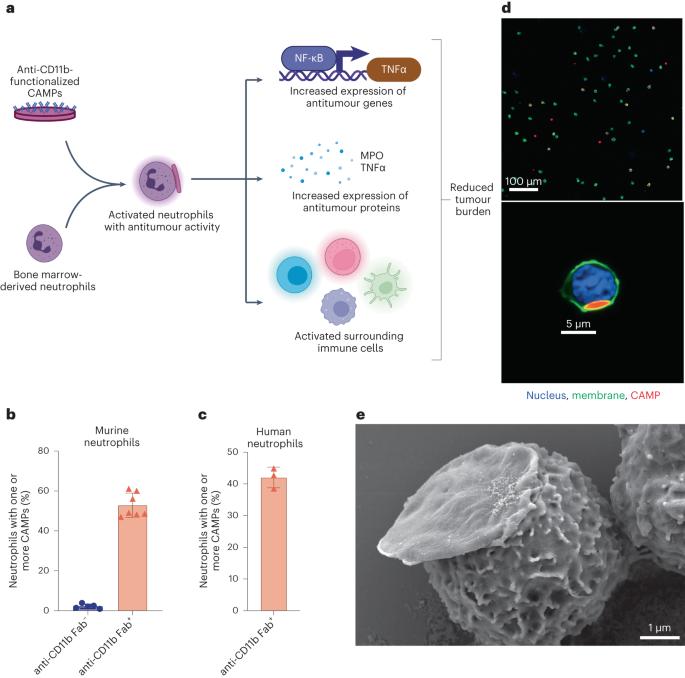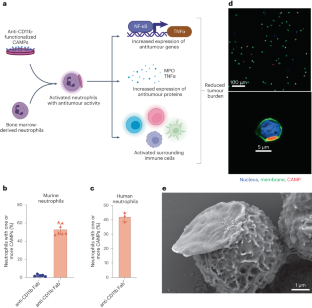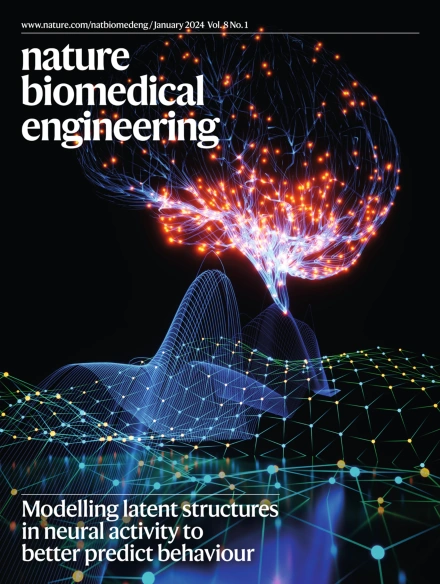中性粒细胞粘附聚合物微补片作为一种无药癌症免疫疗法。
IF 26.8
1区 医学
Q1 ENGINEERING, BIOMEDICAL
引用次数: 0
摘要
与肿瘤相关的中性粒细胞可以发挥抗肿瘤作用,但也可以在免疫抑制的肿瘤微环境中呈现出有利于肿瘤的表型。在这里,我们展示了中性粒细胞可以被盘状聚合物微米 "补丁 "极化为抗肿瘤表型,这些补丁附着在中性粒细胞表面而不被内化。静脉注射微补片的中性粒细胞会在脾脏和肿瘤排出的淋巴结中聚集,并激活脾脏的自然杀伤细胞和T细胞,增加树突状细胞和自然杀伤细胞的聚集。在携带皮下 B16F10 肿瘤或正位 4T1 肿瘤的小鼠中,静脉注射微补片装载的中性粒细胞可产生强大的全身免疫反应,减少肿瘤负荷,提高存活率。微补片激活的中性粒细胞与检查点抑制剂抗细胞毒性T淋巴细胞相关蛋白4结合使用,可有效抑制B16F10肿瘤的生长,三分之一的受试小鼠肿瘤完全消退。微补片装载的中性粒细胞可为基于中性粒细胞的癌症免疫疗法提供一种有效、可扩展且不含药物的方法。本文章由计算机程序翻译,如有差异,请以英文原文为准。


Neutrophils bearing adhesive polymer micropatches as a drug-free cancer immunotherapy
Tumour-associated neutrophils can exert antitumour effects but can also assume a pro-tumoural phenotype in the immunosuppressive tumour microenvironment. Here we show that neutrophils can be polarized towards the antitumour phenotype by discoidal polymer micrometric ‘patches’ that adhere to the neutrophils’ surfaces without being internalized. Intravenously administered micropatch-loaded neutrophils accumulated in the spleen and in tumour-draining lymph nodes, and activated splenic natural killer cells and T cells, increasing the accumulation of dendritic cells and natural killer cells. In mice bearing subcutaneous B16F10 tumours or orthotopic 4T1 tumours, intravenous injection of the micropatch-loaded neutrophils led to robust systemic immune responses, a reduction in tumour burden and improvements in survival rates. Micropatch-activated neutrophils combined with the checkpoint inhibitor anti-cytotoxic T-lymphocyte-associated protein 4 resulted in strong inhibition of the growth of B16F10 tumours, and in complete tumour regression in one-third of the treated mice. Micropatch-loaded neutrophils could provide a potent, scalable and drug-free approach for neutrophil-based cancer immunotherapy. The intravenous injection of neutrophils bearing discoidal polymer microscale ‘patches’ on their surfaces reduces tumour burden in mice owing to the patch-induced polarization of the neutrophils towards an antitumour phenotype.
求助全文
通过发布文献求助,成功后即可免费获取论文全文。
去求助
来源期刊

Nature Biomedical Engineering
Medicine-Medicine (miscellaneous)
CiteScore
45.30
自引率
1.10%
发文量
138
期刊介绍:
Nature Biomedical Engineering is an online-only monthly journal that was launched in January 2017. It aims to publish original research, reviews, and commentary focusing on applied biomedicine and health technology. The journal targets a diverse audience, including life scientists who are involved in developing experimental or computational systems and methods to enhance our understanding of human physiology. It also covers biomedical researchers and engineers who are engaged in designing or optimizing therapies, assays, devices, or procedures for diagnosing or treating diseases. Additionally, clinicians, who make use of research outputs to evaluate patient health or administer therapy in various clinical settings and healthcare contexts, are also part of the target audience.
 求助内容:
求助内容: 应助结果提醒方式:
应助结果提醒方式:


